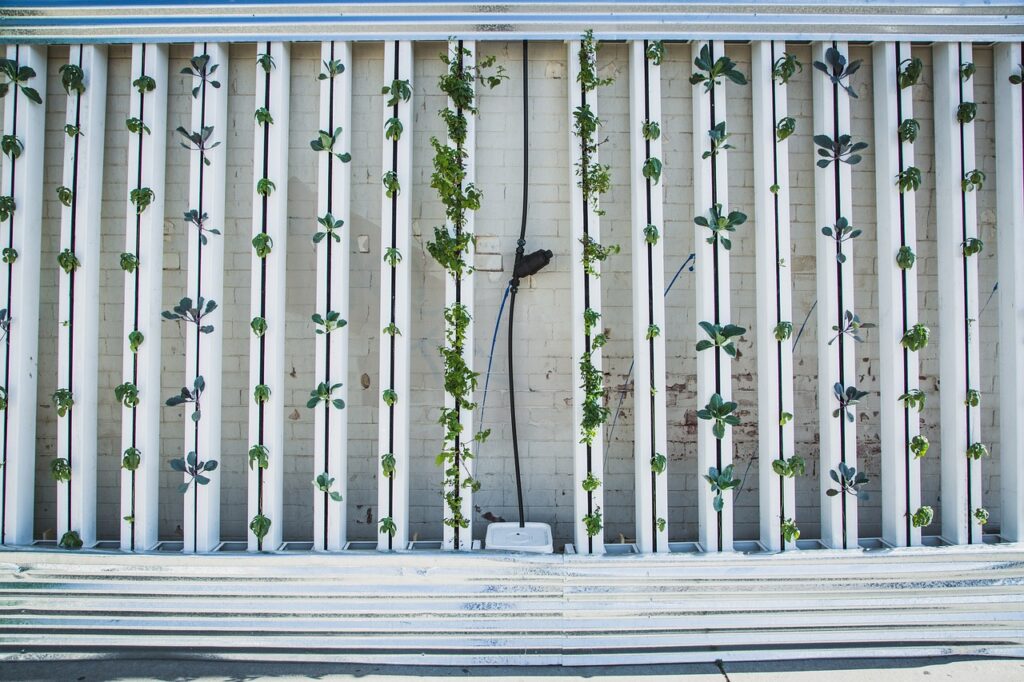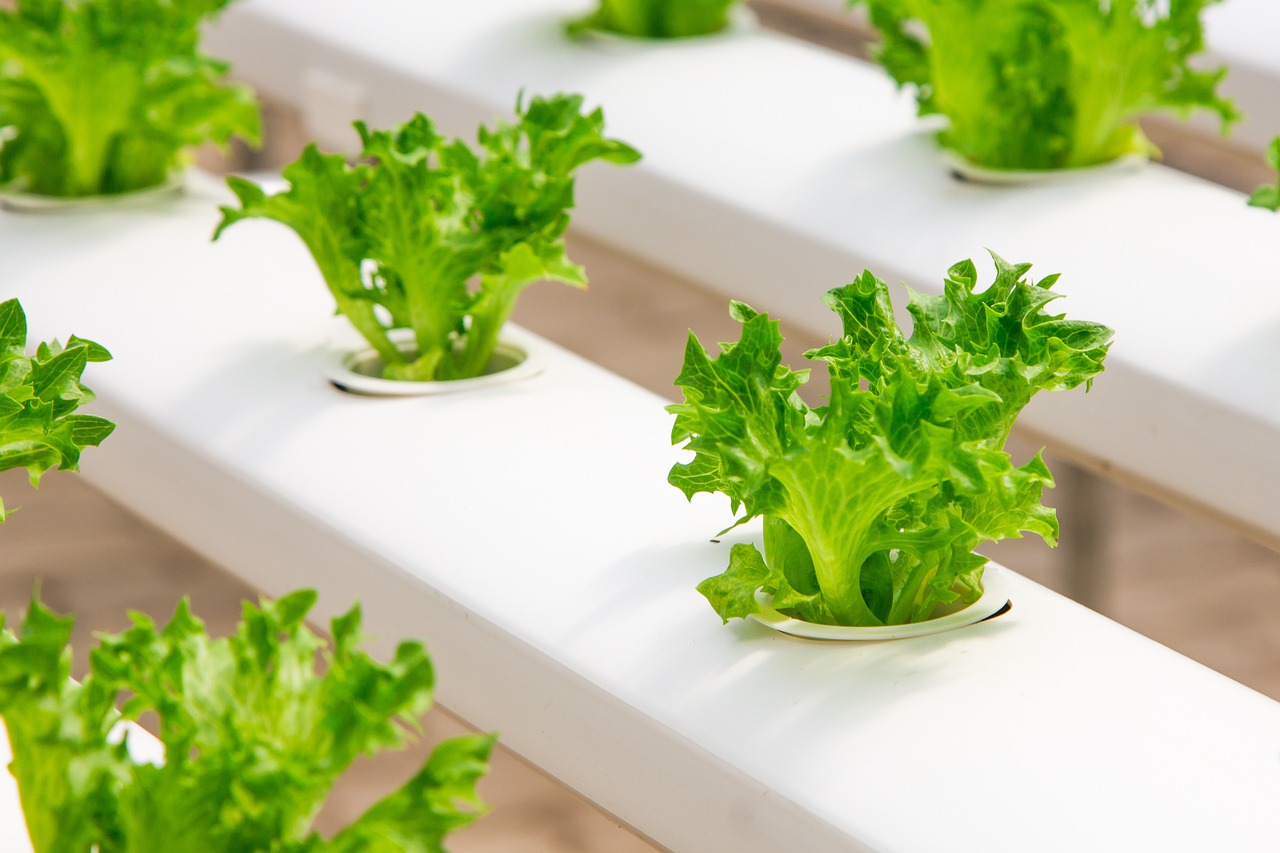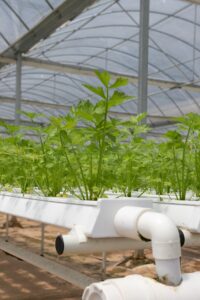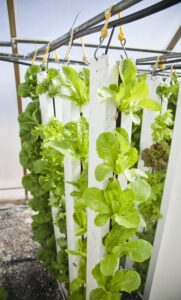One of the earliest mentions of hydroponics is the Hanging Gardens of Babylon; today hydroponics is an accepted and efficient way to ensure a high yield year-round. According to the United Nations another 2,3 billion extra mouths will have to be fed by 2050. For this reason, hydro culture methods of farming like aquaponics, aeroponics and hydroponics have become more popular.
Hydroponics is a form of soilless cultivation; by using water and liquid fertiliser in the place of soil. To feed astronauts during long term space exploration and to stretch resources, NASA researched ways of growing plants in space. They needed something that would minimise water and energy consumption without the use of soil. They realised that the hydroponic method enabled them to filter crop water and deliver the exact nutrients needed, while they could replicate the exact light wavelengths needed at the correct intensity and duration.
They could control the growth environment and keep it at the ideal temperature and humidity. Suburban gardeners and nurseries often use this method of growth. Commercially it is used in developed countries where space is a problem, or where it is very cold or hot and they need climate-controlled environments to produce food.
Hydroponics is also used for food security in urban areas that are far from farmland and where traditional farming might not be able to keep up with demand. If electricity supply can be secured it may also offer solutions to Africa’s challenges. If hydroponics is something that you have been mulling over, there are a few things to take into consideration. Like with any other method of farming, it has its advantages and disadvantages.

Vertical systems take up much less space and produce a larger crop per square metre, but they need additional lighting in most areas of the world. Photo: Pixabay.com
Advantages of hydroponics
- Conserves water: There are different hydroponic methods but all of them have one thing in common: Much less water is being used than in traditional agriculture. Controlled temperatures and smart systems decrease water loss. Water can also be reused after cleaning.
- Creating perfect growth conditions: With hydroponics you can create an optimal environment for plant growth.
- All year-round yields: Many harvests are seasonal and rely on different weather conditions but with hydroponics you can simulate these conditions to ensure your crop grows year-round. In aquaponics you are also able to plant diverse crops all at once.
- Crops grow faster: By creating the ideal blend of nutrients and the ideal environment you can ensure that your crops grow faster.
- Less labour: Unlike traditional farming methods, hydroponics does not need a large workforce. There is no soil preparation, weeding or watering necessary, which eliminates the need for intensive labour.
- Space saving: Because it is soilless, growing a hydroponic crop takes up less space. Stacking methods and vertical hydroponic systems can produce a larger harvest per square metre.
Disadvantages of hydroponics
- Higher set up costs: While it saves you money in the long run, starting up a hydroponic system can be costly. The system setup is expensive, but once you have your system in place the costs decrease. • Relies on electricity: This method unfortunately relies heavily on the use of electricity. There are however ways around this, for example making use of solar power and other alternative energy sources with battery back-up.
- Waterborne diseases: Waterborne diseases can lead to stunted growth and even plant death if it is not observed and corrected early. That is why constant monitoring of your plant health is key.
- High level of maintenance and monitoring: Because these methods rely on an optimal growth environment and the correct nutrients added to the water, they require constant monitoring and maintenance. Maintaining and ensuring your system runs smoothly is also important.
- Not all plants grow vertically: While vertical farming seems like an efficient way of saving space, not all plants are suited for this method. Fruiting crops, trees and shrubs will fall to the ground and need more space. It works for leafy greens and herbs. method. The advantages however far outweigh the disadvantages and, managed correctly hydroponics could provide you with disease-free plants all year round.
- Hydroponics can deliver healthy crops year-round with less water usage. Photo: Pixabay.com
Hydroponic methods:
- Wick system
- Deep water culture
- Nutrient film technique
- Ebb and flow
- Drip systems
- Dutch bucket system
- Aeroponic system
With socio-economic issues like a scarcity of available farming land, rapid climate change, rural-urban migration, and water scarcity becoming a problem, these methods may be the answer to more sustainable farming in the future. Countries like the United States, Japan, China, Singapore, South Korea, Taiwan, Thailand, Germany, France, the United Kingdom, the Netherlands, and Pakistan have already adopted these methods for farming purposes.
“West Africa has been identified as a climate-change hotspot, with climate change likely to lessen crop yields and production, with resultant impacts on food security,” says a United Nations article about the severe global warming consequences for Africa.
In the coming weeks we shall look at the different hydroponic systems, what you need to start your own hydroponic garden or farm, ways of planting, maintenance and harvesting.
References:
Earth.org (https:// earth.org/hydroponic-farming), NASA.gov (https://www.nasa.gov/technology/tech-transfer-spinoffs/ nasa-research-launches-a-newgeneration-of-indoor-farming/), Paris Agreement, UN.org (https://www.un.org/africarenewal/magazine/december-2018-march-2019/ global-warming-severe-consequences-africa).











